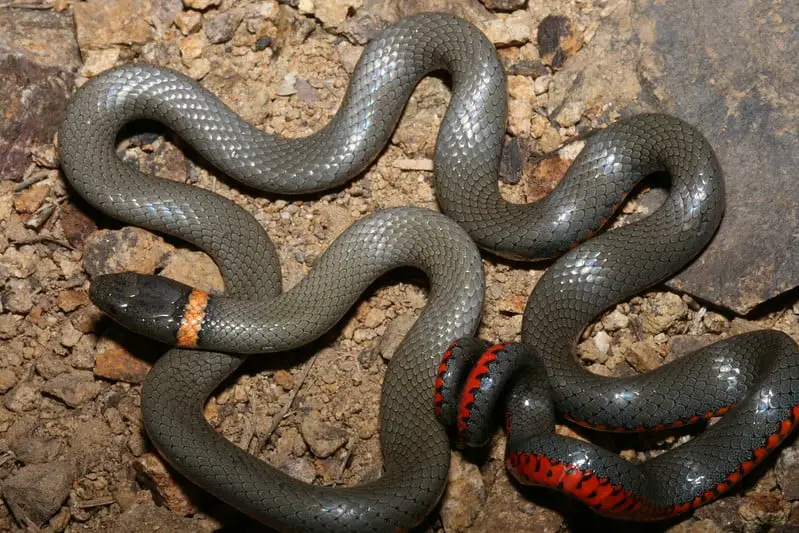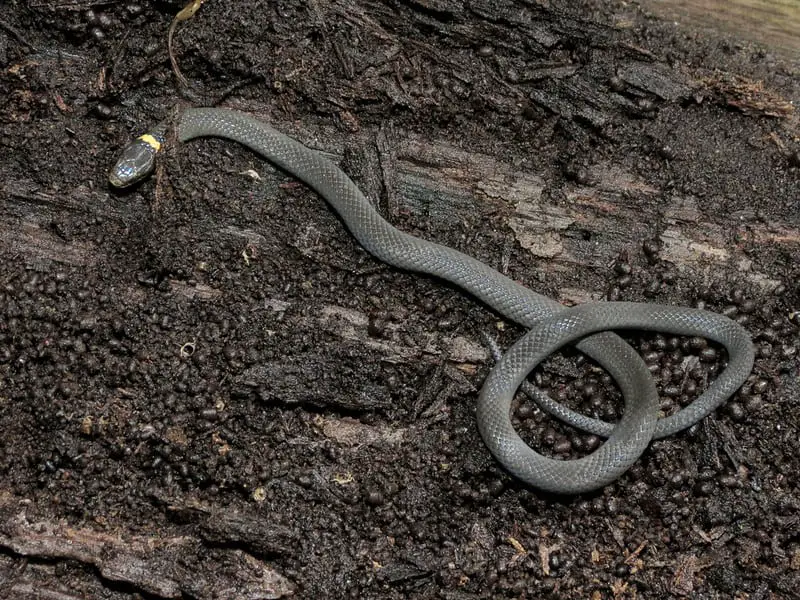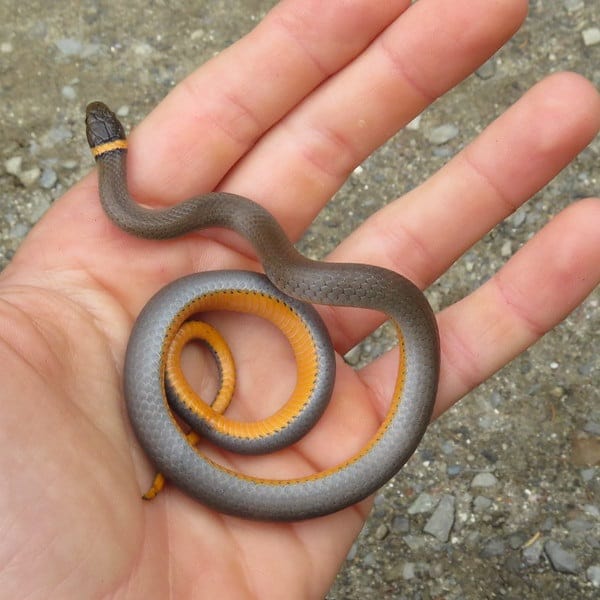The ring-necked snake, Diadophis punctatus, is a harmless small snake that can be found throughout most of the United States and parts of Mexico and Canada. It is mostly grey or brown with a colorful belly side and a colorful ring behind its head.
Ring-Necked Snake Description
The common name of the snake refers to a characteristic yellow, orange, red or cream-colored narrow band around its neck. For most specimen and subspecies, the band forms a solid line across the neck. Some specimen and subspecies exhibit a broken band while a few populations found in Utah do not show any neck band.
The back of the snake is usually brown, grey, dark olive-green or black without any characteristic markings other than the nack ring. The belly of the snake has a strong yellow, orange or red color with small black crescent-shaped patterns. Most commonly, the belly is a bright yellow that turns into a strong red towards the tail.
The colorful belly is not visible when the snake moves on the ground. However, when it feels threatened, the snake curles up its colorful tail to show off the warning colors. Often, the ring-nacked snake rolls on its back completely to show even more of the warning colors and deter attackers.

Ring-necked snakes are sometimes confused with juvenile DeKay’s brown snakes as they sometimes show a band around their neck. They belly is not as colorful, however.
Size
Generally, ring-necked snakes are small snakes that reach a maximum length of 18 inches. The average length depends on the subspecies. Most adult ring-necked snakes reach an average length of 10-15 inches (25-38 cm). The regal ring-necked snake that occurs in Texas and Arizona reaches an averag size of 15-18 inches (38-46 cm).
Diet and Habitat
Ring-necked snakes are secretive snakes that spend most of their time in hiding or underground. They occur most frequently in flatland forests but have adapted to a wide variety of habitats in their large geographic range. The ring-necked snake feeds mostly on earthworms, insect larvae and other small critters. Due to its food preference, it is most commonly found in moist soil with an abundance of earthworms.

Bite
Strictly speaking, the ring-necked snake is a venomous snake. However, given the small size of the snake itself as well as the size of its fangs, it poses no threat to humans or larger pets. For this reason, we have classified the snake as non-venomous on this page.
The snake is also not an aggressive snake and does not use biting as a defense mechanism. When the snake feels thretatened,
Ring-necked snake range in the USA
Members of one of the fourteen subspecies of the ring-necked snake can be found throughout the United States. The largest populations can be found in the eastern part of the U.S. while populations in the west are more scattered. Excluding Alaska, Hawaii, Montana, Wyoming as well as North and South Dakota, the ring-necked snake can be found in every U.S. State. Namely, these are: Alabama, Arkansas, California, Colorado, Connecticut, Delaware, Florida, Georgia, Idaho, Illinois, Indiana, Iowa, Kansas, Kentucky, Louisiana, Maine, Maryland, Massachusetts, Michigan, Minnesota, Mississippi, Missouri, Nebraska, Nevada, New Hampshire, New Jersey, New Mexico, New York, North Carolina, Ohio, Oklahoma, Oregon, Pennsylvania, Rhode Island, South Carolina, South Dakota, Tennessee, Texas, Utah, Vermont, Virginia, Washington, West Virginia and Wisconsin.
Scientific classification of Diadophis punctatus
- Kingdom: Animalia
- Phylum: Chordata
- Class: Reptilia
- Order: Squamata
- Suborder: Serpentes
- Family: Colubridae
- Genus: Diadophis
- Species: Diadophis punctatus
Fourteen subspecies of the ring-necked snake are currently recognized:
- Diadophis punctatus acricus – Key ring-necked snake
- Diadophis punctatus amabilis – Pacific ring-necked snake
- Diadophis punctatus anthonyi – Todos Santos Island ring-necked snake
- Diadophis punctatus arnyi – prairie ring-necked snake
- Diadophis punctatus dugesii – Dugès’ ring-necked snake
- Diadophis punctatus edwardsii – northern ring-necked snake
- Diadophis punctatus modestus – San Bernardino ring-necked snake
- Diadophis punctatus occidentalis – northwestern ring-necked snake
- Diadophis punctatus pulchellus – coralbelly ring-necked snake
- Diadophis punctatus punctatus – southern ring-necked snake
- Diadophis punctatus regalis – regal ring-necked snake
- Diadophis punctatus similis – San Diego ring-necked snake
- Diadophis punctatus stictogenys – Mississippi ring-necked snake
- Diadophis punctatus vandenburgii – Monterey ring-necked snake
